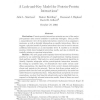234 search results - page 40 / 47 » The elastic net algorithm and protein structure prediction |
ICANN
2001
Springer
14 years 2 days ago
2001
Springer
We distinguish between two main types of model: predictive and explanatory. It is argued (in the absence of models that predict on unseen data) that in order for a model to increas...
BMCBI
2008
13 years 7 months ago
2008
Background: Translation initiation site (TIS) identification is an important aspect of the gene annotation process, requisite for the accurate delineation of protein sequences fro...
BIOINFORMATICS
2006
13 years 7 months ago
2006
Motivation: Protein-protein interaction networks are one of the major post-genomic data sources available to molecular biologists. They provide a comprehensive view of the global ...
GECCO
2008
Springer
13 years 8 months ago
2008
Springer
While John Holland has always envisioned learning classifier systems (LCSs) as cognitive systems, most work on LCSs has focused on classification, datamining, and function appro...
BIBE
2007
IEEE
14 years 1 months ago
2007
IEEE
Abstract—We consider the problem of aligning multiple protein sequences with the goal of maximizing the SP (Sum-of-Pairs) score, when the number of sequences is large. The QOMA (...


